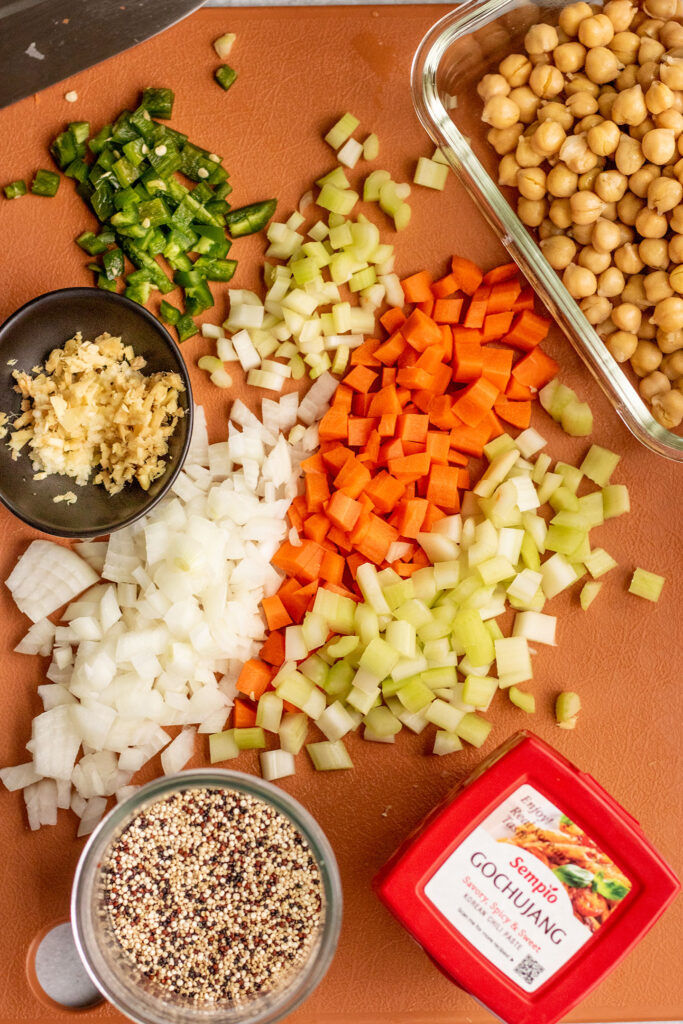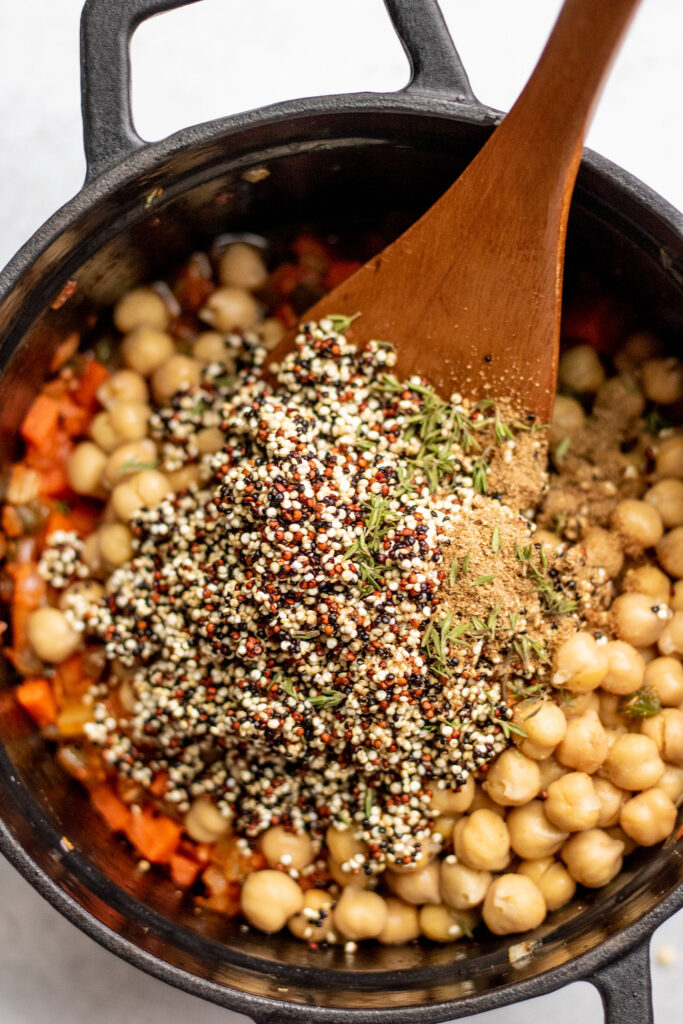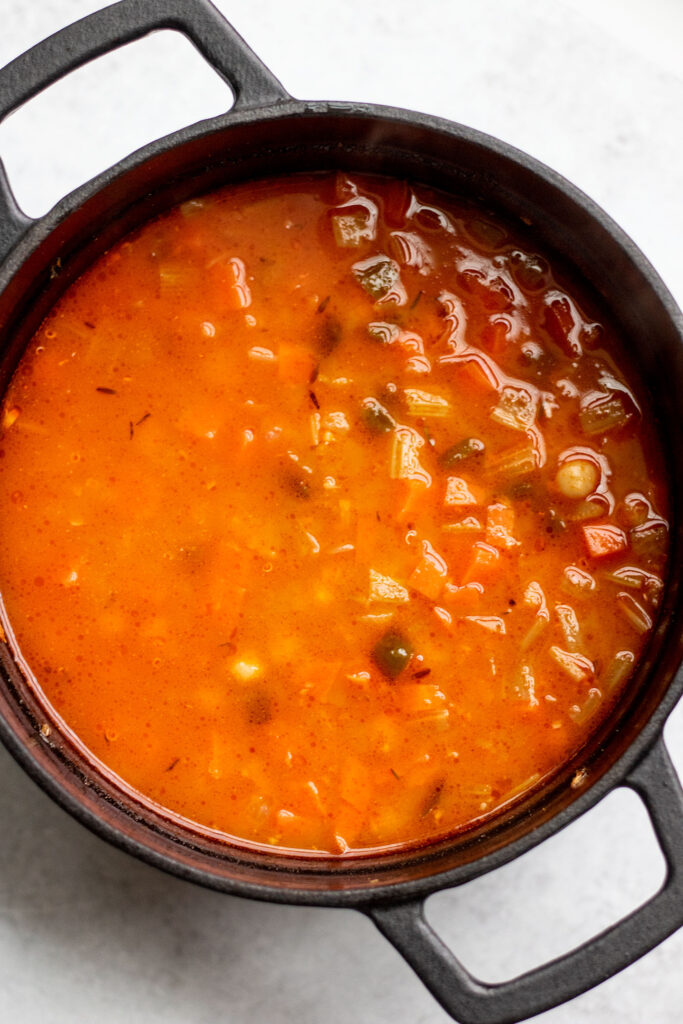Gochujang Chickpea Soup
This Gochujang Chickpea Soup is quick to make, but loaded with lots of warming savory flavors. Comes together in 30 minutes and packed with satisfying protein and fiber.

This Gochujang Chickpea Soup is one of those soul warming kind of soups. Something I find myself coming back to again and again in the winter months especially because it is so easy to make. So if you are looking for a bowl of low effort comfort that also happens to be packed with nutrition, then this soup is for you!
Why You’ll Love This Cozy Chickpea Soup
- Can be cooked in less than 30 minutes. This soup comes together fast, which makes it the perfect weeknight soup. Even the parts that require dicing can be turned into a short cut using some prechopped veggies.
- One pot soup. No fancy equipment needed to make this brothy soup. Everything goes in one pot and simmers on the stove top.
- Protein and fiber packed. A great light, but nutritious soup that gets it’s protein primarily from the chickpeas and quinoa stirred into it. The plant-protein used also packs in good for you gut fiber.

What is gochujang?
Gochujang is an incredible Korean condiment, more specifically a fermented Korean red pepper paste that is savory, slightly sweet and spicy. The fermentation process of this paste gives it a very characteristic taste compared to other pepper paste condiments.
The main ingredients of this paste are gochugaru (ground up Korean red pepper chilies), glutinous rice, a fermented soybean powder called meju powder, barley malt powder and salt. And with the presence of those red chilies, there is capsaicin, an antioxidant that may aid your metabolism and even lower inflammation and pain. Lots of reason to try and incorporate this paste into some meals.
If you are looking for recipes to use gochujang in, I highly recommend trying Bibim Guksu (Gochujang Noodles), Kimchi Jjigae (Kimchi Stew), or this Orange Gochujang Tofu.

Key Ingredients and Substitutions
- Mirepoix: This is a fancy French cooking term that stands for your onion, carrot and celery. This helps to develop flavor right at the beginning of our cooking.
- Jalapeño Pepper: Optional, but I love the extra heat this adds. If not a fan of this pepper, feel free to replace with half of a regular bell pepper.
- Aromatics: For this soup we are using both garlic and ginger. Fresh is best, but if you end up using dried garlic and ginger, just adjust until it tastes to your liking.
- Gochujang: I highly recommend that you do not change this ingredient. Do note that you can find brands that are gluten-free, just make sure to read the ingredients.
- Chickpeas: Canned chickpeas make this soup come together fast. Feel free to use an alternative bean like butter beans or white beans.
- Quinoa: This grain is perfect to use to help keep this soup gluten-free. You can also make this soup using farro or barley, but note that the cooking times and amount of liquid needed may differ depending on the grain used, so adjust accordingly.
- Seasoning: I used a combination of thyme and dry ground coriander to help elevate and infuse more savory flavors into the soup.
- Vegetable Broth: For the best flavor, opt for good quality vegan based broths. I either like to use Better Than Bouillon or opt for a vegan “chicken” bouillon cube.
- Miso Paste: I recommend either yellow or white miso paste just for a little added depth of flavor. If allergic to soy you can try a non-soy based miso paste or replace with two teaspoons of coconut aminos.
- Sesame Oil: I like to finish this soup off using some flavorful toasted sesame oil at the very end.
How to Make Gochujang Chickpea Soup
Heat a small pot or saucepan over medium heat then add the avocado oil to warm through. Add the onions, carrots, celery and jalapeno along with a pinch of salt and sauté until the onions have softened. Add the garlic and ginger then sauté again until fragrant then stir in the gochujang and sauté for 1 minute.


Add in the chickpeas, quinoa, coriander and thyme, then pour in the broth. Bring the pot to a boil, then reduce to a low simmer and cook partially covered with a lid for 15 minutes.


Combine the miso paste with 2 tablespoons of water in a bowl and whisk until no lumps remain. Once the soup has finished cooking, remove from heat and stir in the miso mixture along with the sesame oil. Adjust salt to taste and serve garnished with scallions.
Expert Tips
- Build on flavors. It might be tempting to throw everything in the pot all at once to cook, but sauteing the added veggies and aromatics helps to build and develop more flavor overall.
- Add more veggies. You can always stir in some kale or spinach into your broth for added fiber and nutrients. I also love to sauté some cabbage or diced zucchini in the beginning as well. If adding a lot of veggies, you may wish to add some extra water or broth as needed.
- Adjust the spice to your liking. I love spicy food and will often increase the amount of gochujang I use in this soup. If you are not as into spice, just use the recommended tablespoon in the recipe and make sure to deseed your jalapeno if using.
- Double the recipe. This recipe is designed to be a small batch soup, but if you love it and want to have more on hand, feel free to double the recipe by using the scaling feature available in the recipe card.

Frequently Asked Questions
This is one ingredient I encourage you not to swap. Gochujang has a very unique flavor that is hard to replicate with substitutions. You can find gochujang in Asian markets or even in the International aisle of your local grocery store now that it has gained popularity. If not, you can also order easily online. This brand here is gluten-free and vegan.
While traditional preparations of gochujang include barley malt (a gluten containing ingredient), there are many gochujang products available now that do have gluten-free preparations. Always check ingredients and confirm with packaging labels that indicate that it is gluten-free.
Once the soup has cooled, place in an airtight storage container and keep it in the fridge for up to 5 days. You can also store leftovers in the freezer for up to 3 months. Regardless of storage, you can reheat this soup in a saucepan or in the microwave for a few minutes until it is at your desired temperature.
How to Serve
This soup is ready to serve as is since it has protein, complex carbohydrates and veggies all in one bowl. If you want more protein, I love to add a serving of silken tofu to mimic topping it with some eggs. You can also use some crispy tofu to serve on top or on the side.
More Cozy Vegan Soup Recipes
- Chipotle Red Lentil Potato Soup
- Vegan Gnocchi Tomato Soup
- Roasted Tomato and White Bean Soup
- Vegan Pot Pie Soup


Gochujang Chickpea Soup
- Prep Time: 10 minutes
- Cook Time: 25 minutes
- Total Time: 35 minutes
- Yield: 2–3 servings 1x
- Category: Soup
- Method: One Pot
- Cuisine: American
- Diet: Vegan
Description
This Gochujang Chickpea Soup is quick to make, but loaded with lots of warming savory flavors. Comes together in 30 minutes and packed with satisfying protein and fiber.
Ingredients
- 1/2 tbsp avocado oil
- 1 small yellow onion, diced
- 1 carrot, diced
- 2 stalks celery, diced
- 1 jalapeño pepper, stem and seeds removed and finely diced (or use 1/2 a bell pepper for less heat)
- 3 cloves garlic, crushed or grated
- 1/2 inch ginger, grated
- 1 tbsp gluten-free gochujang
- 1, 15 oz can chickpeas, rinsed and drained
- 1/2 cup quinoa, rinsed well
- 1/2 tsp ground coriander
- 1/4 tsp dry thyme or 5 sprigs fresh thyme, leaves removed from stem
- 2 1/2 cup good quality vegetable broth (or 2 1/2 cups water with 1 vegan chicken bouillon cube)
- 1 tsp yellow or white miso paste
- 2 tsp sesame oil
- Scallions, for garnish
Instructions
- Heat a small pot or saucepan over medium heat then add the avocado oil to warm through. Add the onions, carrots, celery and jalapeno along with a pinch of salt and sauté until the onions have softened.
- Add the garlic and ginger then sauté again until fragrant then stir in the gochujang and sauté for 1 minute.
- Add in the chickpeas, quinoa, coriander and thyme, then pour in the broth. Bring the pot to a boil, then reduce to a low simmer and cook partially covered with a lid for 15 minutes.
- Combine the miso paste with 2 tablespoons of water and whisk until no lumps remain. Once the soup has finished cooking, remove from heat and stir in the miso mixture along with the sesame oil. Adjust salt to taste and serve garnished with scallions.
Notes
Build on flavors. It might be tempting to throw everything in the pot all at once to cook, but sauteing the added veggies and aromatics helps to build and develop more flavor overall.
Add more veggies. You can always stir in some kale or spinach into your broth for added fiber and nutrients. I also love to sauté some cabbage or diced zucchini in the beginning as well. If adding a lot of veggies, you may wish to add some extra water or broth as needed.
Adjust the spice to your liking. I love spicy food and will often increase the amount of gochujang I use in this soup. If you are not as into spice, just use the recommended tablespoon in the recipe and make sure to deseed your jalapeno if using.
Double the recipe. This recipe is designed to be a small batch soup, but if you love it and want to have more on hand, feel free to double the recipe by using the scaling feature available in the recipe card.
If you tried this recipe or any other recipe on the blog, then let me know what you thought in the comments below! And if you loved it, don’t forget to rate it too. Feel free to follow on Instagram, Pinterest, and TikTok for the latest nutrition tips and recipe videos.
★ Catherine
This post contains affiliate links which means I will make a small commission if you purchase from those links. I only recommend and share products that I know, trust and personally use myself!







This looks so good! I can’t wait to try it! I only have toasted sesame oil, which has quite a distinctive flavor. Would you recommend I get regular sesame oil for this recipe?
Thanks!
Actually I made this with both. I actually prefer it with the toasted sesame oil. Hope you enjoy it! 🙂
I’ve made this now a few times and I love it! It’s great to customize and add whatever veggies I have on hand.
Thank you so much Dani! I’m so glad to hear this and yes, totally agree about adding other veggies. It truly makes it so good. 🙂